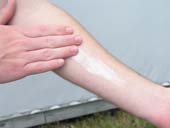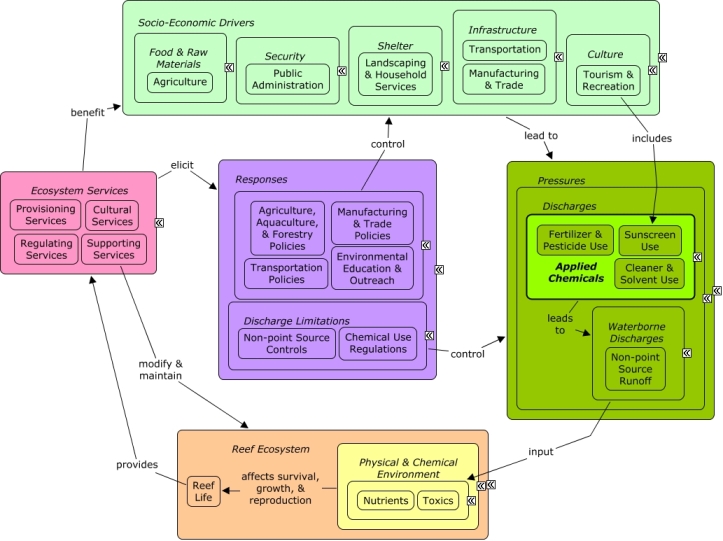ReefLink Database

Sunscreen Use
Sunscreen is a lotion, spray, gel or other topical product that absorbs or reflects some of the sun's ultraviolet (UV) radiation on the skin exposed to sunlight and thus helps protect against sunburn.. Sunscreen ingredients include Benzophenones (dixoybenzone, oxybenzone); PABA and PABA esters (ethyl dihydroxy propyl PAB, glyceryl PABA, p-aminobenzoic acid, padimate-O or octyl dimethyl PABA); Cinnamates (cinoxate, ethylhexyl p-methoxycinnamate, octocrylene, octyl methoxycinnamate); Salicylates (ethylhexyl salicylate, homosalate, octyl salicylate); Digalloyl trioleate; Menthyl anthranilate; or Avobenzone [butyl-methyoxydibenzoylmethane; Parsol 1789]
CMap

CMap Description
A number of socio-economic sectors create pressures on the reef environment through application of chemicals. Sunscreen use by recreational swimmers has been raised as a potential contaminant that can enter the reef ecosystem. Chemicals can affect the survival, growth, and reproduction of reef species. Tourism & recreation sectors directly benefit from many ecosystem services, including the aesthetic value of the reef and clean, calm waters, which provide recreational opportunities and contribute to the cultural identity of the local community. Regulation of chemical use, including registration, labeling, and evaluation of risk, can be used to identify potentially toxic chemicals.Citations
| Citation | Year | Study Location | Study Type | Database Topics |
|---|---|---|---|---|
| Lamb, JB; Willis, BL. 2011. Using Coral Disease Prevalence to Assess the Effects of Concentrating Tourism Activities on Offshore Reefs in a Tropical Marine Park. Conservation Biology 25:1044-1052. | 2011 | Australia | Collaboration & Partnering; Marine Protected Areas; Nutrients; Pathogens; Sunscreen Use; Tourism & Recreation | |
| Starcevic, A., W. C. Dunlap, J. Cullum, J. M. Shick, D. Hranueli, and P. F. Long. 2010. Gene Expression in the Scleractinian Acropora microphthalma Exposed to High Solar Irradiance Reveals Elements of Photoprotection and Coral Bleaching. PLoS One 5:e13975. | 2010 | Algae; Light; Stony Coral; Sunscreen Use | ||
| Danovaro, R., L. Bongiorni, C. Corinaldesi, D. Giovannelli, E. Damiani, P. Astolfi, L. Greci, and A. Pusceddu. 2008. Sunscreens cause coral bleaching by promoting viral infections. Environmental Health Perspectives 116:441-447. | 2008 | US Pacific & Hawaii; US East Coast (NC, SC, GA); India; Pacific Ocean | Lab Study | Algae; Light; Microorganisms; Pathogens; Stony Coral; Sunscreen Use; Tourism & Recreation; Zooxanthellae |
| Eckes, M. J., U. E. Siebeck, S. Dove, and A. S. Grutter. 2008. Ultraviolet sunscreens in reef fish mucus. Marine Ecology Progress Series 353:203-211. | 2008 | Australia | Field Study & Monitoring; Lab Study | Corallivorous Fish; Fish; Large Herbivorous Fish; Light; Sunscreen Use |
| Slattery, M. and V. J. Paul. 2008. Indirect effects of bleaching on predator deterrence in the tropical Pacific soft coral Sinularia maxima. Marine Ecology Progress Series 354:169-179. | 2008 | US Pacific & Hawaii | Field Study & Monitoring | Fish; Invertivorous Fish; Octocoral; Sunscreen Use; Zooxanthellae |
| Tibbetts, J. 2008. Bleached, but not by the sun: sunscreen linked to coral damage. Environmental Health Perspectives 116. | 2008 | Sunscreen Use | ||
| Oren, A. and N. Gunde-Cimerman. 2007. Mycosporines and mycosporine-like amino acids: UV protectants or multipurpose secondary metabolites? FEMS Microbiology Letters 269:10-Jan. | 2007 | Europe | Review | Algae; Cyanobacteria; Microorganisms; Nutrients; Primary Production; Sunscreen Use |
| Zamzow, J. P. 2007. Ultraviolet-absorbing compounds in the mucus of shallow-dwelling tropical reef fishes correlate with environmental water clarity. Marine Ecology Progress Series 343:263-271. | 2007 | South & Central America; Panama; Iran; Caribbean | Fish; Light; Sunscreen Use; Surface & Groundwater Flow | |
| Sommaruga, R., K. Whitehead, J. M. Shick, and C. S. Lobban. 2006. Mycosporine-like Amino Acids in the Zooxanthella-Ciliate Symbiosis Maristentor dinoferus. Protist 157:185-191. | 2006 | Light; Sunscreen Use | ||
| Hallock, P. 2005. Global change and modern coral reefs: New opportunities to understand shallow-water carbonate depositional processes. Sedimentary Geology 175:19-33. | 2005 | Global | Calcium Carbonate Deposition; CO2; Cyanobacteria; Finfish Harvest; Light; Microorganisms; Nutrients; Pathogens; Sediment; Sunscreen Use; Surface & Groundwater Flow; Toxics | |
| Shick, J. M., C. Ferrier-Pages, R. Grover, and D. Allemand. 2005. Effects of starvation, ammonium concentration, and photosynthesis on the UV-dependent accumulation of mycosporine-like amino acids (MAAs) in the coral Stylophora pistillata. Marine Ecology Progress Series 295:135-156. | 2005 | Light; Primary Production; Special Use Permitting; Stony Coral; Sunscreen Use; Zooxanthellae | ||
| Salih, A., A. Larkum, T. Cronin, J. Wiedenmann, R. Szymczak, and G. Cox. 2004. Biological properties of coral GFP-type proteins provide clues for engineering novel optical probes and biosensors. Proceedings of SPIE - The International Society for Optical Engineering 5329:61-72. | 2004 | Australia | Sunscreen Use | |
| Yakovleva, I. and M. Hidaka. 2004. Diel fluctuations of mycosporine-like amino acids in shallow-water scleractinian corals. Marine Biology 145:863-873. | 2004 | Japan | Algae; Light; Stony Coral; Sunscreen Use | |
| Maruyama, T., E. Hirose, and M. Ishikura. 2003. Ultraviolet-light-absorbing tunic cells in didemnid ascidians hosting a symbiotic photo-oxygenic prokaryote, Prochloron. Biological Bulletin 204:109-113. | 2003 | Light; Sunscreen Use | ||
| Sunshine, S. 2003. Surfing injuries. Current sports medicine reports2:136-141. | 2003 | Sunscreen Use | ||
| Shick, J. M. and W. C. Dunlap. 2002. Mycosporine-like amino acids and related gadusols: Biosynthesis, accumulation, and UV-protective functions in aquatic organisms. Annual Review of Physiology 64:223-262. | 2002 | Review | Algae; Light; Microorganisms; Special Use Permitting; Sunscreen Use | |
| [No author name available]. 2001. Corals wear fluorescent sunscreen. Photonics Spectra 35:40. | 2001 | Sunscreen Use | ||
| Robinson, K. 2001. Corals use fluorescent pigments as sunscreen. Biophotonics International 8:40. | 2001 | Sunscreen Use | ||
| Dunlap, W. C. 1999. Sunscreens, oxidative stress and antioxidant functions in marine organisms of the Great Barrier Reef. Redox Report 4:304-306. | 1999 | Australia | Microorganisms; Pathogens; Stony Coral; Sunscreen Use | |
| Shick, J. M., S. Romaine-Lioud, C. Ferrier-Pages, and J.-P. Gattuso. 1999. Ultraviolet-B radiation stimulates shikimate pathway-dependent accumulation of mycosporine-like amino acids in the coral Stylophora pistillata despite decreases in its population of symbiotic dinoflagellates. Limnology and Oceanography 44:1667-1682. | 1999 | Light; Stony Coral; Sunscreen Use; Zooxanthellae | ||
| Volkman, J. K. 1999. Australasian research on marine natural products: Chemistry, bioactivity and ecology. Marine and Freshwater Research 50:761-779. | 1999 | Australia | Review | Algae; Fish; Microorganisms; Pharmaceuticals & Cosmetics; Pharmaceuticals & Cosmetics Sources; Sponges; Sunscreen Use |
| Dunlap, W. C., B. E. Chalker, W. M. Bandaranayake, and J. J. Wu Won. 1998. Nature's sunscreen from the Great Barrier Reef, Australia. Pages 41-51 in International Journal of Cosmetic Science. | 1998 | Australia | Light; Pharmaceuticals & Cosmetics; Pharmaceuticals & Cosmetics Sources; Stony Coral; Sunscreen Use |
Management Options
| Management Option | Description | Sources | Database Topics |
|---|---|---|---|
| Data Management & Decision Tools: Research and Model Causal Linkage Between Pollutants and Ecological Impact | This involves conducting research to identify and document causal linkages between discharge water pollutants and specific, quantifiable ecological problems. The natural environment naturally assimilates some pollutants, but has thresholds for this type of contaminant processing. Different hydrology, biology and spatial/temporal factors are all going to play a roll in the linkage between pollutants and ecological problems, meaning modeling and risk assessment can be beneficial. | NOAA Marine Sanctuary Program. 2007. Florida Keys National Marine Sanctuary revised management plan. National Ocean Service, Key West, FL. |
Applied Chemicals; Biological Monitoring & Restoration; Biological Monitoring, Mapping, & Scientific Research; Chemical Variables; Cleaner & Solvent Use; Decision Support; Discharge Limitations; Discharges; Ecosystem Monitoring & Restoration; Environmental Monitoring & Restoration; Environmental Monitoring, Mapping, & Scientific Research; Fertilizer & Pesticide Use; Non-point Source Controls; Non-point Source Runoff; Nutrient & Contaminant Processing; Petroleum Spills; Physical & Chemical Water Quality Criteria; Point & Mobile Source Controls; Point Source Discharges; Reef Inhabitants; Regulating Services; Sewage Treatment; Stormwater Management; Sunscreen Use; Supporting Services; Toxics; Wastewater Discharge; Water; Waterborne Discharges; Wetlands |
| Environmental Education: Deliver Non-Enforcement Resource Eductaion at the Resource Site | Voluntary compliance (#50) is the most desirable form of site protection. Lack of compliance often occurs unintentionally, due to a lack of knowledge and understanding. Law enforcement plays a role by ensuring rules are appropriately followed, but often the preventative component of this enforcement becomes secondary, especially on high use days/areas. Volunteers can assist by answering questions and talking to people recreating about the reef, reef resources, and how to appropriately recreate. Volunteers can watch to ensure people are acting appropriately, that boaters do not go too close to shallow reefs, and that groundings do not occur. Programs such as Team OCEAN have contributed over 15,000 hours to such activities. | NOAA Marine Sanctuary Program. 2007. Florida Keys National Marine Sanctuary revised management plan. National Ocean Service, Key West, FL. |
Beaches & Nature Parks; Boat Movement; Boating Activities; Collaboration & Partnering; Cultural Policies; Culture; Dive, Snorkeling, & Swimming Tourism; Education & Information; Environmental Education & Outreach; Finfish Harvest; Invertebrate Harvest; Marine Debris; Recreational Fishing; Recreational Opportunities; Resource Use Management; Social Organizations; Sunscreen Use; Tourism & Recreation; Tourism & Recreation Policies; Trampling |
| Restoration: Beach Renourishment and Nourishment | Beaches are subject to natural accretion and erosion. Tourism is often best supported by wide, accessible, public sandy beaches. Beaches can be restored to counteract natural erosion by transporting large quantities of sand onto the beach. This sand often comes from nearby dredging. Caution should be used when restoring long sections of beaches, as often the area above the mean high tide line is littoral, or privately owned, and restoration of these beaches can impact these property rights, see "Stop the Beach Renourishment, Inc. v. Florida Department of Environmental Protection (2010) U.S. Supreme Court decision." Beach protection or nourishment offers an alternative to this often expensive and abrupt type of renourishment, nourishment involves practices which encourage coastal accretion and discourage erosional forces. See "Florida's Beach and Shore Preservation Act" for some restrictions on this. | NOAA Coastal Services Center. Beach Nourishment: A Guide for Local Government Officials. Coastal Services Center Accessed 6/17/2011. |
Beach & Land Formation; Beaches & Nature Parks; Culture; Dredging, Draining, & Filling; Environmental Monitoring & Restoration; Landscape Conservation & Restoration; Recreational Opportunities; Shoreline Armoring; Shoreline Protection; Sunscreen Use; Tourism & Recreation |
Laws
| Legal Citation | Purpose of Law | Management Organization | Database Topics |
|---|
